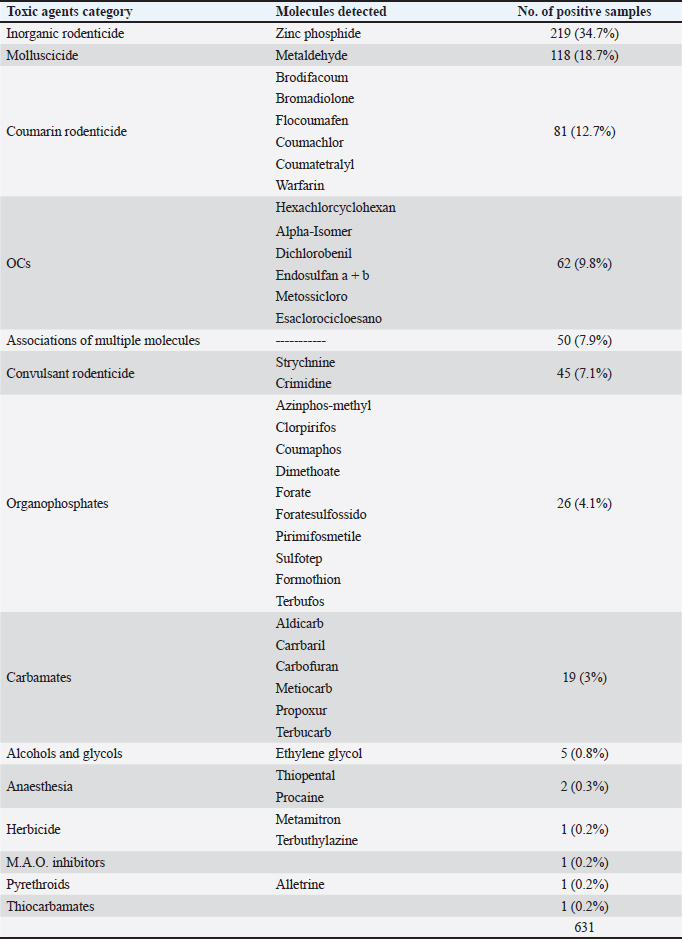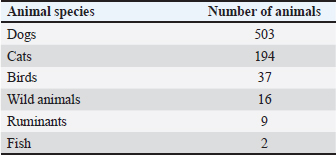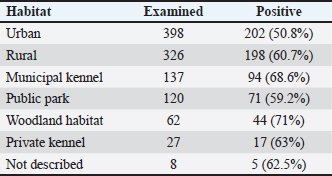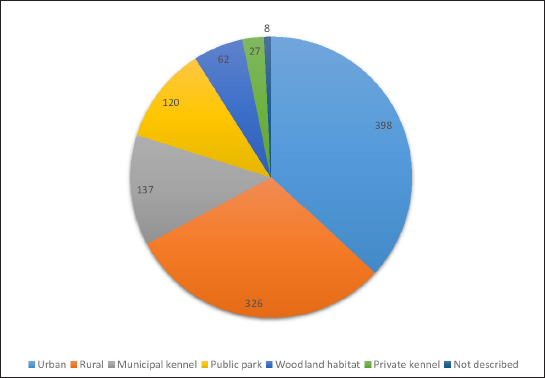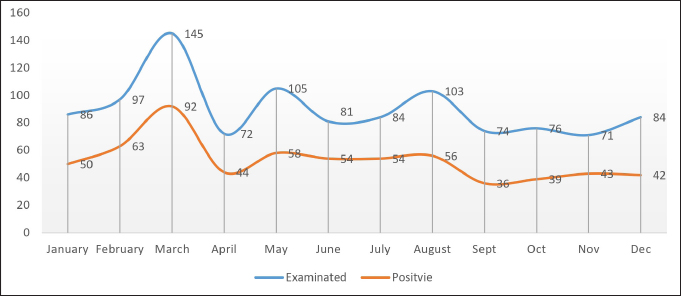
| Research Article | ||
Open Vet. J.. 2024; 14(12): 3241-3247 Open Veterinary Journal, (2024), Vol. 14(12): 3241-3247 Research Article Retrospective analysis of animal poisoning in the province of Viterbo, ItalyDavide Santori*, Samuele Dottarelli, Sofia Cucci, Sara Tonon, Antonino Barone, Deborah Gobbi, Francesco Napoli, Erminia Sezzi, Alessio Gelli, Anna Rita Pifferi, Giuseppe Proietti, Silvia Abbruzzese, Luca Silveri, Francesca Di Donato, Rita Fanelli and Alberto Maria BrozziIsitituto Zooprofilattico Sperimentale del Lazio e della Toscana M. Aleandri, Italy *Corresponding Author: Davide Santori. Isitituto Zooprofilattico Sperimentale del Lazio e della Toscana M. Aleandri, Italy. Email: davide.santori [at] izslt.it Submitted: 06/08/2024 Accepted: 05/11/2024 Published: 31/12/2024 © 2024 Open Veterinary Journal
AbstractBackground: Intentional poisoning represents a serious health risk for domestic and wild animals, this phenomenon has been widespread in Italy for several years. Aim: Our study aims to examine data on animal poisonings that occurred in the province of Viterbo, Lazio region located in central Italy, from 2003 to 2017. The aim of this study is to provide data on the poisoning of animals in the province of Viterbo. Methods: A total of 1,078 cases of suspected poisoning were analysed during the period under review. Of these, 761 (70.6%) were carcasses, 189 (17.6%) were baits, 107 (9.9%) were gastric contents, and 21 (1.9%) were samples of various origins. Results: A total of 631 cases (58.5%) were confirmed as involving toxic substances. Zinc phosphide (34.7%) was the most prevalent cause of poisoning, followed by metaldehyde (18.7%), a coumarin rodenticide (12.7%), other molecules were also identified with lower percentages. The animal species most frequently involved in poisoning are dogs (66.2%), followed by cats (25.5%), birds (4.9%), while wild animals, ruminants, and fish represent a small percentage of animals involved. Conclusion: This phenomenon represents a significant threat to animals, humans, and the environment. Therefore, it is essential to implement effective measures to combat this issue. Keywords: Animal poisoning, Baits, Italy, Pets poisoning, Viterbo. IntroductionIn Europe (Berny et al., 2010; Guitart et al., 2010) and specifically in Italy (Bille et al., 2016), the intentional poisoning of animals represents a risk to public health, the environment, and non-target animals. A wide array of reasons may underlie the illegal killing of animals through poison. In urban settings, interpersonal conflicts such as neighborhood problems and intolerance towards stray or owned animals are among the main causes, whereas in rural areas poison can be used to kill animals believed to negatively affect human activities such as hunting, farming, agriculture, and truffle search (Bille et al., 2016). In 2008, the Italian Ministry of Health promulgated an ordinance on the “Rules on the prohibition of use and detention of baits or poisoned bites” (Ministerial Order of 18 December, 2008). This ordinance specifies that only certified organizations may use authorized baits and biocides in public spaces (Reg. EU 2012/528) to prevent harm to unintended targets, including humans. The ordinance is still in force and bans the use of poisoned baits. It mandates that any suspected animal poisoning or the presence of poisoned bait must be reported to appointed official Authorities. Moreover, to detect crimes against animals, the network of Italian Istituti Zooprofilattici Sperimentali, operating as national official laboratories, must perform free anatomical and toxicological examinations on animals whenever clinical suspicion arises. These institutes are local focal points for monitoring and toxicological analysis in collaboration with judicial authorities (Avolio et al., 2021). Despite the 2009 ban, numerous studies have documented the continued use of poisoned baits in numerous Italian regions (Amorena et al., 2009; Giorgi and Mengozzi, 2011; Bille et al., 2016; Chiari et al., 2017; De Roma et al., 2017, 2018) although there is no published data on the Province of Viterbo. Our work aims to analyze data from our database covering the years 2003 to 2017. Materials and MethodsData and samples collectionIn this study, data related to samples received by the Viterbo territorial department of the Istituto Zooprofilattico Sperimentale del Lazio e della Toscana from 2003 to 2017 were analyzed. A total of 1,078 samples were analyzed, 761 carcasses (70.6%), 189 (17.6%) baits, 107 (9.9%) vomits, and 21 (1.9%) other samples (e.g., faces, water) as shown in Table 1. The animal carcasses received, underwent a post mortem examination to detect typical poisoning lesions, while organs and biological samples (e.g., gastric contents) were selected for toxicological investigations. The delivered bites, vomit, and gastric lavage, were inspected to detect the possible presence of toxic substances. Study areaThe province of Viterbo is located in the Lazio region of central Italy. It has a population of 309.795 habitants (Permanent Census of Lazio Region ISTAT, 2021) and an area of 3.615,24 km² divided into 60 municipalities among which the main town is Viterbo. It borders Tuscany (provinces of Grosseto and Siena), and Umbria (province of Terni) to the north, the province of Rieti to the east, the metropolitan city of Rome to the south, and the Tyrrhenian Sea to the west. Data analysisAll data were included into a computerized spreadsheet (Microsoft Office Excel) and analyzed with R 2023.06.1 Build 524 (Team R: a language environment for statistical computing, 2022). Frequency analyses based on toxicological results were performed for all samples submitted. Samples analysisAll samples considered to be suspected poisoning were analyzed by gas chromatography-mass spectrometry (GC-MS) (Trace 1300—Trace ISQ, Thermo Fisher Scientific, Inc., Waltham, MA) and Liquid chromatography-tandem mass spectrometry (LC MS/MS) (Agilent 1100 series—API 3000, Applied Biosystems, Foster City, CA). To approximately 1 g of homogenized sample, 0.2 g of sodium chloride is added to improve the extraction of the analytes. 10 ml of acetonitrile is added and centrifuged. The supernatant is purified in QuEChERS–dispersive SPE Centrifuge (Thermo Fisher Scientific, Inc., Waltham, MA), part of the supernatant is taken to dryness in nitrogen flow at 40°C and imaged with chloroform (GC-MS analysis), another part is taken to dryness in nitrogen flow at 40°C and imaged with 80% acetonitrile (LC-MS/MS analysis). ResultsGeneral information about examined casesDuring the period under review, 1,078 cases of suspected poisoning were examined, 761 (70.6%) were carcasses, 189 (17.6%) bites, 107 (9.9%) gastric contents, and 21 (1.9%) samples of various origins. A total of 631 (58.5%) cases of toxic substances were confirmed. Poisoned animal species and different habitats where the poisonings occurred were reported, and the seasonal trend of poisonings was also taken into account. Toxic compounds involvedTable 2 provides a comprehensive overview of the toxic agents involved in animal poisoning cases and found in poisoned baits. Zinc phosphide (34.7%), an inorganic rodenticide, was the main cause of poisoning, followed by metaldehyde (18.7%), coumarin rodenticide (12.7%), organochlorines (OCs) (9.8%), associations of multiple molecules (7.9%), convulsant rodenticide (7.1%), organophosphates (4.1%), carbamates (3%), alcohols and glycols (0.8%), anesthesia (0.3%), herbicide (0.2%), Monoamine oxidase inhibitor (M.A.O.) (0.2%), Pyrethroids (0.2%), and Thiocarbamates (0.2%). Species involved and habitatTable 3 shows the animal species involved in poisoning cases. The animal species most frequently involved in poisoning are dogs (66.2%), followed by cats (25.5%), birds (4.9%), wild animals (2.1%), ruminants (1.2%), and fish (0.3%). An important aspect of the poisoning cases concerns the habitat where they occurred. The habitats are shown in Table 4 and Figure 1. In the urban area, 398 cases were tested with a positive result for 202 (50.8%) cases. In the rural habitat, 198 (60.7%) positive cases were identified out of 326 tested. In municipal kennels, 94 (68.6%) cases were identified out of 137 tests, in public parks 71 (59.2%) cases out of 120, in forest areas 44 (71%) positives cases out of 62, in private kennels 17 (63%) cases out of 27 tested. Five (62.5%) positives were found in unspecified areas. Seasonal trendFigure 2 shows the seasonal trend of suspected poisonings and confirmed cases from 2003 to 2017. Table 1. Analysed samples.
Table 2. Toxic agents involved in animal poisoning cases.
In January, the confirmed suspected poisoning cases were 50/86, in February 63/97, in March 92/145, in April the confirmed cases were 44/72, in May 58/105, and in June 54/81. In July, the confirmed cases were 54/84, in August 56/103, in September 36/74, in October 39/76, in November 43/71, and in December 42/84. Table 3. Animal species involved in poisoning cases .
Table 4. Habitat where poisoning cases occurred and positive found.
DiscussionOne of the main problems in poisoning cases of animals is the impossibility of distinguishing between accidental and malicious cases (Bertero et al., 2020). Unlike humans, animals cannot communicate what they have ingested or the circumstances surrounding it. This creates significant hurdles in determining intent (Guitart et al., 2010). Among the main reasons for a difficult discernment is limited case information, veterinarians primarily rely on the owner’s account of the animal’s behavior and access to potential toxins (Bille et al., 2016). However, the owner might not have witnessed the poisoning or may be unwilling to disclose crucial details. Another problem relates to overlapping symptoms; many poisons cause this phenomenon, making it difficult to distinguish between accidental exposure and deliberate poisoning on the basis of clinical presentation alone. In this study, we analyzed 1,078 suspected poisoning cases, providing valuable insights into the types of toxins involved, affected species, habitat distribution, and seasonal trends. By the term “poisoning cases”, we have included both animal carcasses (including gastric contents and vomit) and bites. The results showed that zinc phosphide (34.7%), a rodenticide, was the most common compound, followed by metaldehyde (18.7%) and coumarin (12.7%), both of which are also used for rodent control. This highlights the significant threat that rodenticides represent to non-target animals (Amorena et al., 2004). The seasonal distribution of cases suggests a potential link with rodent control practices (Srilakshmi et al., 2023). In early spring (March), higher confirmed poisoning rates were observed, possibly coinciding with increased rodent activity and subsequent bait application. During the summer (August), rodents can find many sources of food; consequently, they are less likely to eat baits, which increases the risk that baits are eaten by untargeted animals, notably dogs (Lefebvre et al., 2017).
Fig. 1. Habitat where poisoning cases occurred.
Fig. 2. Distribution of examined and positive samples per month from 2003 to 2017. OCs are a group of synthetic chemicals that contain chlorine (Pattnaik et al., 2020); their presence (9.8%) indicates potential exposure to persistent environmental contaminants. They were widely used as pesticides, insecticides, and industrial chemicals from the 1940s to the 1970s. However, OCs have been banned in most countries due to their harmful effects on human health and the environment (Kang and Chang, 2011). The diversity of other toxic substances, including convulsant rodenticides, organophosphates, and carbamates, underlines the complexity of the animal poisoning landscape. As regards the species involved in poisoning cases, dogs were the most common victims (66.2%), probably due to their search behavior and potential attraction to the bait. Cats (25.5%) were the second most affected, potentially due to exposure to rodent baits placed around homes. The species poisoned less frequently are birds (4.9%), wild animals (2.1%), ruminants (1.2%), and fish (0.3%). As for birds, they can be poisoned through a number of mechanisms, including direct ingestion of poisoned bait. This is the most common cause of bird poisoning, and it can occur when birds scavenge on poisoned bait intended for rodents or other animals. Birds may also be attracted to the bait due to its bright colors or sweet smell. Green is considered to be a color that is avoided by some bird species and may make baits less conspicuous against vegetation (Schmidt et al., 2004; Clapperton et al., 2015). Secondary poisoning occurs when birds consume the carcasses of poisoned animals. The toxins from the poisoned animal can accumulate in the bird’s tissues, leading to poisoning. Birds can be poisoned by exposure to pesticides, herbicides, and other toxic chemicals that are, determined by the toxicity of the active ingredient and the likelihood and degree of exposure (Greig-Smith, 1992; Pascual et al., 1999). This can happen if they ingest contaminated food or water, or if they come into direct contact with the chemicals. Fish may have been poisoned as a result of poisoned water due to the presence of a bite. Wild animals may have been poisoned directly to prevent their entry into private areas or may have ingested poisoned bites not intended for them. However, the rare cases of poisoning of wild animals, ruminants, and fish suggest that these are accidental and not malicious events, which may have been caused by mishandling of potentially toxic products. Special attention must be focused on the habitats where the poisoning cases occurred. Urban and rural areas were the most affected with 202 and 198 positive cases, respectively. An important data concerns municipal kennels, this place, which should normally be a safe place for animals, was the place of death for animals 94 times. This phenomenon also occurred in private kennels, although to a lesser extent with 17 cases of positivity. The highest number of poisoning cases were recorded in late winter and spring, this trend could be due to the increased circulation of animals. For dogs, for example, the number of walks with their owners may increase, for wild animals, it corresponds to the resumption of the period of searching for food. The seasonal trend remained unchanged for each year examined. ConclusionOur study highlights how cases of poisoning are a common problem in the province of Viterbo. The presence of poisoned bites can be harmful not only to animals but the poison can spread in the environment, polluting water and soil. This can lead to possible contact of the poison with humans, exposing them to a serious risk to their health. Despite the existence of several Ministry of Health ordinances that prohibit the sale and use of specific substances, cases of poisoning caused by these prohibited molecules continue to occur. To raise awareness among the population and all those involved, the Ministry of Health has established the national poisoning portal, which serves as a repository for all cases. The urban habitat is the one most affected by poisoning phenomena; an educational program aimed at preserving the human–animal relationship could be useful. AcknowledgmentsNone. Conflict of interestThe authors declare no conflict of interest. FundingThis research received no external funding. Data availabilityAll data supporting the findings of this study are available within the manuscript. Authors’ contributionsConceptualization, D.S., A.M.B; data curation, D.S., E.S., R.F., F.D.D., S.C., S.D., A.B, S.T., D.G., F.N., A.G., A.R.P., G.P., S.A., L.S., A.M.B.; writing—original draft preparation, D.S., A.M.B..; writing—review and editing D.S., E.S.; supervision, E.S., D.S., A.M.B. All authors have read and agreed to the published version of the manuscript. ReferencesAmorena, M., Caloni, F. and Mengozzi, G. 2004. Epidemiology of intoxications in Italy. Vet. Res. Commun. 28(Suppl. 1), 89–95. Amorena, M., Visciano, P., Giacomelli, A., Marinelli, E., Sabatini, A.G., Medrzycki, P., Oddo, L.P., De Pace, F.M., Belligoli, P., Di Serafino, G., Saccares, S., Formato, G., Langella, V. and Perugini, M. 2009. Monitoring of levels of polycyclic aromatic hydrocarbons in bees caught from beekeeping: Remark 1. Vet. Res. Commun. 33, 165–167. Avolio, R., Andreoli, T., Ercolini, C., Mignone, W., Beltrame, R., Razzuoli, E., Modesto, P., Zoppi, S., Crescio, M.I., Ostorero, F., Gili, M., Abete, M.C., Meloni, D. and Dellepiane, M. 2021. Retrospective data analysis of animal poisoning events in Liguria. Vet. Anim. Sci. 13, 100178. Berny, P., Caloni, F., Croubels, S., Sachana, M., Vandenbroucke, V., Davanzo, F. and Guitart, R. 2010. Animal poisoning in Europe. Part 2: companion animals. Vet. J. 183(3), 255–259. Bertero, A., Chiari, M., Vitale, N., Zanoni, M., Faggionato, E., Biancardi, A. and Caloni, F. 2020. Types of pesticides involved in domestic and wild animal poisoning in Italy. Sci. Total Environ. 707, 136129. Bille, L., Toson, M., Mulatti, P., Dalla Pozza, M., Capolongo, F., Casarotto, C., Ferrè, N., Angeletti, R., Gallocchio, F. and Binato, G. 2016. Epidemiology of animal poisoning: an overview on the features and spatio-temporal distribution of the phenomenon in the north-eastern Italian regions. Forensic Sci. Int. 266, 440–448. Chiari, M., Cortinovis, C., Vitale, N., Zanoni, M., Faggionato, E., Biancardi, A. and Caloni, F. 2017. Pesticide incidence in poisoned baits: a 10-year report. Sci. Total Environ. 601, 285–292. Clapperton, B.K., Day, T.D., Morgan, D.K.J., Huddart, F., Cox, N. and Matthews, L.R. 2015. Palatability and efficacy to possums and rats of pest control baits containing bird repellents. New Zeal. J. Zool. 42(2), 104–118. De Roma, A., Miletti, G., D’Alessio, N., Marigliano, L., Bruno, T., Gallo, P., Binato, G. and Esposito, M. 2018. Inspective and toxicological survey of the poisoned baits and bites. Forensic Sci. Int. 287, 108–112. De Roma, A., Miletti, G., D’Alessio, N., Rossini, C., Vangone, L., Galiero, G. and Esposito, M. 2017. Metaldehyde poisoning of companion animals: a three-year retrospective study. J. Vet. Res. 61(3), 307–311. European Commission Regulation No. 528/2012 of 22 May 2012 concerning the making available on the market and use of biocidal products. Available via https://eur-lex.europa.eu/legal-content/IT/TXT/PDF/?uri=CELEX:32012R0528 Giorgi, M. and Mengozzi, G. 2011. Malicious animal intoxications: poisoned baits. Vet. Med.-Czech. 56(4), 173–179. Greig-Smith, P.W. 1992. A European perspective on ecological risk assessment, illustrated by pesticide registration procedures in the United Kingdom. Environ Toxicol. Chem. 11(12), 1673–1689. Guitart, R., Croubels, S., Caloni, F., Sachana, M., Davanzo, F., Vandenbroucke, V. and Berny, P. 2010. Animal poisoning in Europe. Part 1: farm livestock and poultry. Vet. J. 183(3), 249–254. Kang, J.H. and Chang, Y.S. 2011. Organochlorine pesticides in human serum. In: Pesticides - Strategies for Pesticides Analysis. InTech. https://doi.org/10.5772/13642 Lefebvre, S., Fourel, I., Queffélec, S., Vodovar, D., Mégarbane, B., Benoit, E., Siguret, V. and Lattard, V. 2017. Poisoning by anticoagulant rodenticides in humans and animals: causes and consequences. InTech. https://doi.org/10.5772/intechopen.69955 Ministerial Order of 18 December. 2008. Rules on the prohibition of use and detention of baits or poisoned bites. Available viahttps://www.izsvenezie.it/documenti/temi/avvelenamenti/provvedimenti/2008-12-18-ordinanza.pdf Pascual, J.A., Hart, A.D.M. and Fryday, S.L. 1999. Incidence of lethal bird poisoning reduced by regurgitation of pesticide-treated food. Environ. Toxicol. Chem. 18(2), 247–253. https://doi.org/10.1897/1551-5028(1999)018<0247:IOLBPR>2.3.CO;2 Pattnaik, M., Pany, B.K., Dena, J., Pal, A.K. and Sahu, G. 2020. Effect of organochlorine pesticides on living organisms and environment. Chem. Sci. Rev. Lett. 9, 682–686. Permanent Census of Lazio Region ISTAT (2021). Available via https://www.istat.it/it/files//2021/02/Censimento-permanente-della-popolazione_Lazio.pdf Schmidt, V., Schaefer, H.M. and Winkler, H. 2004. Conspicuousness, not colour as foraging cue in plant-animal signalling. Oikos 106(3), 551–557. Srilakshmi, E., Ujefa, S., Komali, G., Priya, T.D., Dhanush, B. and Kantamaneni, P. 2023. A comprehensive review on rodenticide poisoning and its management. World J. Pharm. Res. 12(7), 1061–1074. Team R: a language environment for statistical computing. 2022. R Core RT. Computing. | ||
| How to Cite this Article |
| Pubmed Style Santori D, Dottarelli S, Cucci S, Tonon S, Barone A, Gobbi D, Napoli F, Sezzi E, Gelli A, Pifferi AR, Proietti G, Abbruzzese S, Silveri L, Donato FD, Fanelli R, Brozzi AM. Retrospective analysis of animal poisoning in the province of Viterbo, Italy. Open Vet. J.. 2024; 14(12): 3241-3247. doi:10.5455/OVJ.2024.v14.i12.9 Web Style Santori D, Dottarelli S, Cucci S, Tonon S, Barone A, Gobbi D, Napoli F, Sezzi E, Gelli A, Pifferi AR, Proietti G, Abbruzzese S, Silveri L, Donato FD, Fanelli R, Brozzi AM. Retrospective analysis of animal poisoning in the province of Viterbo, Italy. https://www.openveterinaryjournal.com/?mno=214337 [Access: November 22, 2025]. doi:10.5455/OVJ.2024.v14.i12.9 AMA (American Medical Association) Style Santori D, Dottarelli S, Cucci S, Tonon S, Barone A, Gobbi D, Napoli F, Sezzi E, Gelli A, Pifferi AR, Proietti G, Abbruzzese S, Silveri L, Donato FD, Fanelli R, Brozzi AM. Retrospective analysis of animal poisoning in the province of Viterbo, Italy. Open Vet. J.. 2024; 14(12): 3241-3247. doi:10.5455/OVJ.2024.v14.i12.9 Vancouver/ICMJE Style Santori D, Dottarelli S, Cucci S, Tonon S, Barone A, Gobbi D, Napoli F, Sezzi E, Gelli A, Pifferi AR, Proietti G, Abbruzzese S, Silveri L, Donato FD, Fanelli R, Brozzi AM. Retrospective analysis of animal poisoning in the province of Viterbo, Italy. Open Vet. J.. (2024), [cited November 22, 2025]; 14(12): 3241-3247. doi:10.5455/OVJ.2024.v14.i12.9 Harvard Style Santori, D., Dottarelli, . S., Cucci, . S., Tonon, . S., Barone, . A., Gobbi, . D., Napoli, . F., Sezzi, . E., Gelli, . A., Pifferi, . A. R., Proietti, . G., Abbruzzese, . S., Silveri, . L., Donato, . F. D., Fanelli, . R. & Brozzi, . A. M. (2024) Retrospective analysis of animal poisoning in the province of Viterbo, Italy. Open Vet. J., 14 (12), 3241-3247. doi:10.5455/OVJ.2024.v14.i12.9 Turabian Style Santori, Davide, Samuele Dottarelli, Sofia Cucci, Sara Tonon, Antonino Barone, Deborah Gobbi, Francesco Napoli, Erminia Sezzi, Alessio Gelli, Anna Rita Pifferi, Giuseppe Proietti, Silvia Abbruzzese, Luca Silveri, Francesca Di Donato, Rita Fanelli, and Alberto Maria Brozzi. 2024. Retrospective analysis of animal poisoning in the province of Viterbo, Italy. Open Veterinary Journal, 14 (12), 3241-3247. doi:10.5455/OVJ.2024.v14.i12.9 Chicago Style Santori, Davide, Samuele Dottarelli, Sofia Cucci, Sara Tonon, Antonino Barone, Deborah Gobbi, Francesco Napoli, Erminia Sezzi, Alessio Gelli, Anna Rita Pifferi, Giuseppe Proietti, Silvia Abbruzzese, Luca Silveri, Francesca Di Donato, Rita Fanelli, and Alberto Maria Brozzi. "Retrospective analysis of animal poisoning in the province of Viterbo, Italy." Open Veterinary Journal 14 (2024), 3241-3247. doi:10.5455/OVJ.2024.v14.i12.9 MLA (The Modern Language Association) Style Santori, Davide, Samuele Dottarelli, Sofia Cucci, Sara Tonon, Antonino Barone, Deborah Gobbi, Francesco Napoli, Erminia Sezzi, Alessio Gelli, Anna Rita Pifferi, Giuseppe Proietti, Silvia Abbruzzese, Luca Silveri, Francesca Di Donato, Rita Fanelli, and Alberto Maria Brozzi. "Retrospective analysis of animal poisoning in the province of Viterbo, Italy." Open Veterinary Journal 14.12 (2024), 3241-3247. Print. doi:10.5455/OVJ.2024.v14.i12.9 APA (American Psychological Association) Style Santori, D., Dottarelli, . S., Cucci, . S., Tonon, . S., Barone, . A., Gobbi, . D., Napoli, . F., Sezzi, . E., Gelli, . A., Pifferi, . A. R., Proietti, . G., Abbruzzese, . S., Silveri, . L., Donato, . F. D., Fanelli, . R. & Brozzi, . A. M. (2024) Retrospective analysis of animal poisoning in the province of Viterbo, Italy. Open Veterinary Journal, 14 (12), 3241-3247. doi:10.5455/OVJ.2024.v14.i12.9 |






